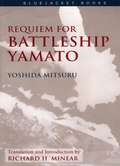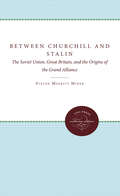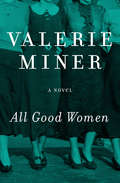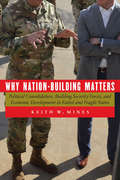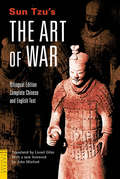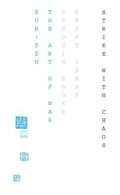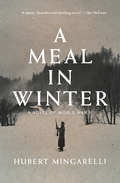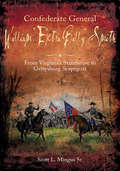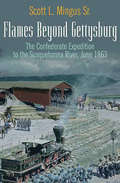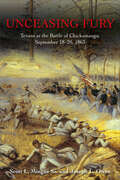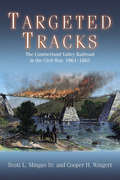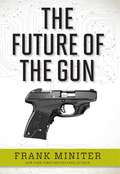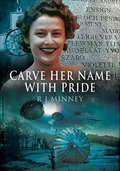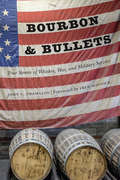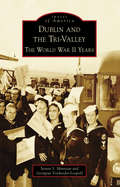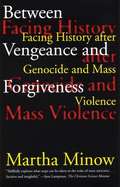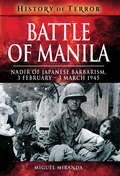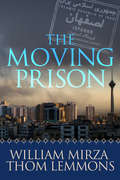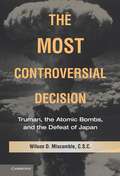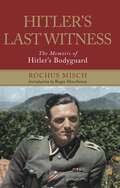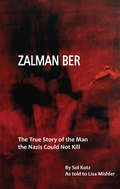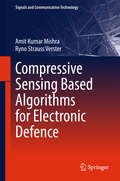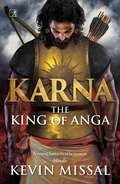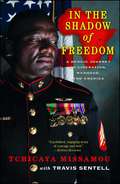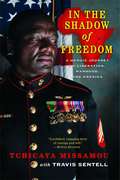- Table View
- List View
Requiem for Battleship Yamato
by Richard Minear Yoshida MitsuruA young ensign on the bridge of the fabled battleship Yamato during her final battle, recounts his experience.
Between Churchill and Stalin: The Soviet Union, Great Britain, and the Origins of the Grand Alliance
by Steven Merritt MinerIt is well documented that relations between the Allies and the Soviet Union were deteriorating from 1943. This volume examines the causes of this conflict that may, in fact, have started in 1940 with the problems of the Baltic states.Originally published 1988.A UNC Press Enduring Edition -- UNC Press Enduring Editions use the latest in digital technology to make available again books from our distinguished backlist that were previously out of print. These editions are published unaltered from the original, and are presented in affordable paperback formats, bringing readers both historical and cultural value.
All Good Women: A Novel
by Valerie MinerAs World War II rages abroad, a group of women forge the bonds of sisterhood in AmericaIn 1938, while tensions in Europe are reaching a boiling point, four young women with big ambitions enter secretarial school in San Francisco. Motivated to attain the financial stability that eluded their parents, they go to battle for their futures. Moira, of Scottish descent, dreams of being an actress. Ann yearns for the education her Jewish immigrant parents provided for her brother, but not for her. Japanese American Wanda experiences firsthand the racial injustices running rampant in the United States. And Teddy, who left the Dust Bowl for sunny California, comes to startling realizations about herself as the war progresses. These women will be both buoyed and challenged by their dreams, experiencing love, loss, and everything in between. Against the backdrop of a nation gripped by fear and paranoia, Miner eloquently captures the spirit of wartime on the home front.
Why Nation-Building Matters: Political Consolidation, Building Security Forces, and Economic Development in Failed and Fragile States
by Keith W. MinesNo one likes nation-building. The public dismisses it. Politicians criticize it. The traditional military disdains it, and civilian agencies lack the blueprint necessary to make it work. Yet functioning states play a foundational role in international security and stability. Left unattended, ungoverned spaces can produce crises from migration to economic collapse to terrorism. Keith W. Mines has taken part in nation-building efforts as a Special Forces officer, diplomat, occupation administrator, and United Nations official. In Why Nation-Building Matters he uses cases from his own career to argue that repairing failed states is a high-yield investment in our own nation&’s global future. Eyewitness accounts of eight projects––in Colombia, Grenada, El Salvador, Somalia, Haiti, Darfur, Afghanistan, and Iraq—inform Mines&’s in-depth analysis of how foreign interventions succeed and fail. Building on that analysis, he establishes a framework for nation-building in the core areas of building security forces, economic development, and political consolidation that blend soft and hard power into an effective package. Grounded in real-world experience, Why Nation-Building Matters is an informed and essential guide to meeting one of the foremost challenges of our foreign policy present and future.
Sun Tzu's The Art of War: Bilingual Edition Complete Chinese and English Text
by John Minford Lionel Giles Sun TzuSun Tzu's The Art of War has been the premier manual of Chinese military strategy for the past two millennia and, as thousands of Asian businessmen can attest, this classic work is as applicable to the corporate world as it is to the battlefield.<P><P>This is the only contemporary edition of the classic Lionel Giles translation to contain all of the translator's original notes, to help you better understand Sun Tzu's powerful maxims and apply them in your daily life. John Minford's foreword brings insights to this classic text and its timeless relevance to the modern world.This edition also marks the first time Giles' translation has been converted to Hanyu Pinyin--the standard Chinese romanization system. Additionally, the book contains the full Chinese language version of the text, along with Giles' extensive notes, with their original Chinese text references to the historical Chinese commentators, making this edition a treasure to military scholars, martial artists, and those planning to use Sun Tzu's strategies to conquer the business world.Sun Tzu's The Art of War will arm you with the knowledge that has allowed those who have studied this classic to gain victory--and often, total domination--over those who remain ignorant of its sage advice.
The Art of War
by John Minford Sun-TzuThe perfect books for the true book lover, Penguin's Great Ideas series features twelve more groundbreaking works by some of history's most prodigious thinkers. Each volume is beautifully packaged with a unique type-driven design that highlights the bookmaker's art. Offering great literature in great packages at great prices, this series is ideal for those readers who want to explore and savor the Great Ideas that have shaped our world.Offering ancient wisdom on how to use skill, cunning, tactics and discipline to outwit your opponent, this bestselling 2000-year-old military manual is still worshipped by soldiers on the battlefield and managers in the boardroom as the ultimate guide to winning.
A Meal in Winter: A Novel of World War II
by Hubert MingarelliThis tale of the Holocaust &“will make many think of the stories of Ernest Hemingway . . . a reminder of the power a short, perfect work of fiction can wield&” (The Wall Street Journal). This timeless short novel begins one morning in the dead of winter, during the darkest years of World War II, with three German soldiers heading out into the frozen Polish countryside. They have been charged by their commanders with tracking down and bringing back for execution &“one of them&”—a Jew. Having flushed out a young man hiding in the woods, they decide to rest in an abandoned house before continuing their journey back to the camp. As they prepare food, they are joined by a passing Pole whose virulent anti-Semitism adds tension to an already charged atmosphere. Before long, the group&’s sympathies begin to splinter when each man is forced to confront his own conscience as the moral implications of their murderous mission become clear. Described by Ian McEwan as &“sparse, beautiful and shocking,&” A Meal in Winter is a &“stark and profound&” work by a Booker Prize–nominated author (The New York Times). &“Sustains tension until the very last page.&” —Kirkus Reviews, starred review
Confederate General William "Extra Billy" Smith: From Virginia's Statehouse to Gettysburg Scapegoat
by Scott L. Mingus Sr.Winner of the 2013 Nathan Bedford Forrest History Book Award for Southern History.Nominated for the 2014 Virginia Book Award for Non-fictionWilliam "Extra Billy" Smith, the oldest and one of the most controversial Confederate generals on the field at Gettysburg, was also one of the most colorful and charismatic characters of the Civil War and the antebellum Old South. Despite a life full of drama, politics, and adventure, until now very few books have been written on Smith since a biased account in the 19th century by his brother-in-law. Scott L. Mingus Sr. has ably filled this historical void with Confederate General William "Extra Billy" Smith: From Virginia's Statehouse to Gettysburg Scapegoat.Known nationally as "Extra Billy" because of his prewar penchant for finding loopholes in government postal contracts to gain extra money for his stagecoach lines, Smith served as Virginia's governor during both the War with Mexico and the Civil War, served five terms in the US Congress, and was one of Virginia's leading spokesmen for slavery and States' Rights. Extra Billy's extra-long speeches and wry sense of humor were legendary among his peers. A lawyer during the heady Gold Rush days, Smith made a fortune in California and, like his income earned from stagecoaches, quickly lost it.Despite his advanced age Smith took the field and fought well at First Manassas, was wounded at Seven Pines and again at Sharpsburg, and marched with Lee's Army of Northern Virginia into Pennsylvania. There, on the first day at Gettysburg, Smith's frantic messages about a possible Union flanking attack remain a matter of controversy to this day. Did his aging eyes see distant fence-lines that he interpreted as approaching enemy soldiers--mere phantoms of his imagination?--or did his prompt action stave off a looming Confederate disaster? What we do know is that his calls for support diverted limited Confederate manpower away from attacks against Cemetery Hill and Culp's Hill that might have turned the tide of Southern fortunes in Pennsylvania.Mingus's biography draws upon a wide array of newspapers, diaries, letters, and other firsthand accounts to paint a broad, deep, and colorful portrait of one of the South's most interesting leaders and devoted sons. Complete with original maps and photos, Extra Billy Smith will satisfy anyone who loves politics, war, and a story well told.
Flames Beyond Gettysburg: The Confederate Expedition to the Susquehanna River, June 1863
by Scott L. Mingus Sr.An in-depth look at a Confederate general and the first blood spilled at Gettysburg, with maps, photos, and a guide to historic sites. This book examines the key role played by Lt. Gen. Richard Ewell&’s Second Corps during the final days in June. It is the first in-depth study of these crucial summer days that not only shaped the course of the Gettysburg Campaign but altered the course of our nation&’s history. In two powerful columns, Ewell&’s Corps swept toward the strategically important Susquehanna River and the Pennsylvania capital looming beyond. Fear coursed through the local populace while Washington and Harrisburg scrambled to meet the threat. One of Ewell&’s columns included a veteran division under Jubal Early, whose objectives included the capture and ransom of towns and the destruction of railroad bridges and the Hanover Junction rail yard. Early&’s most vital mission was the seizure of the Columbia Bridge, which spanned the Susquehanna River between Wrightsville and Columbia. To capture the longest covered bridge in the world would allow the division to cross into prosperous Lancaster County and move against the capital in Harrisburg. Flames Beyond Gettysburg vividly narrates both sides of Ewell&’s drama-filled expedition, including key Southern decisions, the response of the Pennsylvania militiamen and civilians who opposed the Confederates, and the burning of the Columbia Bridge. It also features detailed driving tours of the various sites discussed in the book. Based upon extensive primary source material and featuring original maps by cartographer Steven Stanley, this fast-paced and gracefully written history is a welcome and important addition to the Gettysburg literature.
Unceasing Fury: Texans at the Battle of Chickamauga, September 18-20, 1863
by Scott L. Mingus Sr. Joseph L. Owen&“Focuses on the extensive contributions to the pyrrhic Confederate victory at Chickamauga made by the brave Lone Star State soldiers.&” —Eric J. Wittenberg, award–winning author of Destined to Fail After Gettysburg, it was the Civil War&’s largest battle, but until recently, little of consequence had been written about Chickamauga. You can count on one hand the number of authors who have tackled Chickamauga in any real depth, and most of their works cover the entire battle. Left unmined and mostly forgotten are the experiences of specific brigades, regiments, and state-affiliated troops. Scott Mingus and Joseph Owen&’s Unceasing Fury: Texans at the Battle of Chickamauga, September 18–20, 1863 is the first full-length book to examine in detail the role of troops from the Lone Star State. Texas troops fought in almost every major sector of the sprawling Chickamauga battlefield, from the first attacks on September 18 on the bridges spanning the creek to the final attack on Snodgrass Hill on September 20. Fortunately, many of the survivors left vivid descriptions of battle action, the anguish of losing friends, the pain and loneliness of being so far away from home, and their often-colorful opinions of their generals. The authors of this richly detailed study based their work on hundreds of personal accounts, memoirs, postwar newspaper articles, diaries, and other primary sources. Their meticulous work provides the first exploration of the critical role Texas enlisted men and officers played in the three days of fighting near West Chickamauga Creek in September 1863. Unceasing Fury provides the Lone Star State soldiers with the recognition they have so long deserved.
Targeted Tracks: The Cumberland Valley Railroad in the Civil War, 1861–1865
by Scott L. Mingus Sr. Cooper H. WingertThe Civil War was the first conflict in which railroads played a major role. Although much has been written about their role in general, little has been written about specific lines. The Cumberland Valley Railroad, for example, played an important strategic role by connecting Hagerstown, Maryland to Harrisburg, Pennsylvania. Its location enhanced its importance during some of the Civil War’s most critical campaigns. Despite the line’s significance to the Union war effort, its remarkable story remains little known. The publication of Targeted Tracks: The Cumberland Valley Railroad in the Civil War, 1861-1865, by Scott L. Mingus Sr. and Cooper H. Wingert, rectifies that oversight. Because of its proximity to major cities in the Eastern Theater, the Cumberland Valley Railroad was an enticing target for Confederate leaders. As invading armies jostled for position, the CVRR’s valuable rolling stock was never far from their minds. Northern military and railway officials, who knew the line was a prized target, coordinated—and just as often butted heads—in a series of efforts to ensure the railroad’s prized resources remained out of enemy hands. When they failed to protect the line, as they sometimes did, Southern horsemen wrought havoc on the Northern war effort by tearing up its tracks, seizing or torching Union supplies, and laying waste to warehouses, engine houses, and passenger depots. In October 1859, Abolitionist John Brown used the CVRR in his fateful Harpers Ferry raid. The line was under direct threat by invading Confederates during the Antietam Campaign, and the following summer suffered serious damage during the Gettysburg Campaign. In 1864, Rebel raiders burned much of its headquarters town, Chambersburg, including the homes of many CVRR employees. The railroad was as vital to residents of the bustling and fertile Cumberland Valley as it was to the Union war effort. Targeted Tracks is grounded on the railway’s voluminous reports, the letters and diaries of local residents and Union and Confederate soldiers, official reports, and newspaper accounts. The primary sources, combined with the expertise of the authors, bring this largely untold story to life.
The Future of the Gun
by Frank MiniterThe history of the American gun is intricately entwined with the history of America itself. Promising developments in gun technology could change not only America's future, but the future of the world. Unfortunately, the radical anti-gun lobby is standing between innovation and the American people. Bestselling author Frank Miniter details the amazing breakthroughs waiting to happen in gun technology that could make today's firearms exponentially safer and smarter-if the anti-gun lobby weren't halting progress in its tracks.In The Future of the Gun, you will learn:Why anti-gun groups often oppose gun safetyfeatures How guns-and gun education for young people-cut crime How federalism could save your gun rights New trends in gun technology that will make guns safer and more effectiveWhy most talk about "assault rifles" is bogus How military and civilian gun technology have always advanced in tandem-for the benefit of soldiers and private citizens What guns could look like in just a few yearsWant to know about the future of guns? There is no better place to start than here.ter, more powerful handguns at prices (when adjusted for inflation) the world has never seen.Taurus, a Brazilian gun maker, played with using 3D printers to make guns over a decade ago. A Texas manufacturer has now made Model 1911 pistols out of steel with 3D printers ... the genie is out of the bottle.
Carve Her Name with Pride: The Story Of Violette Szabo (Pen and Sword Military Classics)
by R J MinneyThe thrilling and inspiring true story of Violette Szabo, the fearless British cloak-and-dagger agent who infiltrated Nazi occupied France. Switchboard operator and volunteer for the Women&’s Land Army, Violette Szabo was only twenty-two years old when her husband, Etienne, a captain in the French Foreign Legion, died at El Alamein. His death only made the resilient young widow more determined than ever to join England&’s war effort in World War II. To Violette&’s surprise, opportunity came at the request of Britain&’s Special Organization Executive. The purpose of the SOE was to conduct sabotage and espionage, and to aide local resistance movements in occupied Europe. Trained in secret in the Scottish Highlands, Violette became an expert in fieldcraft, covert navigation, and weapons and demolition. Then, on June 7, 1944, Szabo parachuted into Limoges. Her task was to coordinate the work of the French Resistance in the first days after D-Day. Violette Szabo was about to make history. &“Violette&’s bravery and spirit shine throughout&” this arresting true story of a heroic woman, undaunted by her missions, or the reality of the fate that would most likely await her in the closing years of war. R. J. Minney&’s stirring historical narrative was the basis for the classic 1959 film starring Virginia Mckenna and Paul Scofield (Portland Book Review).
Bourbon and Bullets: True Stories of Whiskey, War, and Military Service
by Fred Minnick John C. TramazzoAmerican soldiers, sailors, airmen, and marines carried whiskey at Yorktown, Gettysburg, Manila, and Da Nang. It bolstered their courage, calmed their nerves, and treated their maladies. As a serious American whiskey drinker, John C. Tramazzo noticed how military service and whiskey went hand in hand during his service as a commissioned officer in the U.S. Army. In Bourbon and Bullets Tramazzo reveals the rich and dramatic connection between bourbon and military service in America. Although others have discussed whiskey’s place in military history, Bourbon and Bullets explores the relationship between military service and some of the most notable whiskey distillers and executives working today. American servicemen Weller, Handy, Stagg, Van Winkle, and Bulleit all experienced combat before they became household names for American whiskey enthusiasts. In small towns and big cities across America, veterans of armed conflict in Panama, Somalia, Haiti, Iraq, and Afghanistan cook mash, operate stills, and push the booming industry to new heights. Bourbon and Bullets delves into the lives and military careers of these whiskey distillers and tells the story of whiskey’s role on the battlefield and in the American military community.
Dublin and the Tri-Valley: The World War II Years (Images of America)
by Steven S. Minniear Georgean Vonheeder-LeopoldIn 1941, the Navy sought West Coast locations for bases to ship men, material, and equipment into World War II's Pacific theater. The Dublin and Livermore area offered wide-open spaces with good transportation routes to the San Francisco Bay area. Near Dublin, the Navy built Camp Parks, Camp Shoemaker, and Shoemaker Naval Hospital. Camp Parks prepared Seabees to build and maintain airfields, ports, and hospitals from Guadalcanal to Japan. Hundreds of thousands of other sailors and WAVES came to Camp Shoemaker on their way from basic training to postings on ships, bases, and stations throughout the Pacific. Shoemaker Hospital saw them again when they returned injured or ill. Farther east, the Navy built Livermore Naval Air Station to train thousands to fly.
Between Vengeance and Forgiveness: Facing History after Genocide and Mass Violence
by Martha MinowThis is a book on justice and healing after horrific violence. Remembering and forgetting, judging and forgiving, reconciling and avenging, grieving and educating - the author Martha Minow shows us why each may be necessary, yet painfully inadequate, as individuals and societies confront past horrors.
Battle of Manila: Nadir of Japanese Barbarism, 3 February–3 March 1945 (History of Terror)
by Miguel MirandaThis &“extensively researched and well-illustrated&” history recounts the bloody fight to liberate Manila from occupation during WWII (WWII History Magazine). For nearly four years during the Second World War, Japanese occupation had devastated the Philippines. Then, in 1944, General MacArthur led a massive army of American and Filipino forces determined to take back the island nation. Essential to the Philippine Campaign was recapturing the country&’s once-glittering capital city, Manila. In late January of 1945, the Allied forces embarked on the necessary and urgent mission. Trapped within the old University of Santo Tomas were thousands of ailing prisoners at risk of torture and death by their captors. As the desperate Japanese navy fought to keep the advancing Americans at bay, Japanese troops began killing civilians caught in the crossfire—or using them as human shields. Thousands of Filipinos were trapped in what became the most bitter combat seen in the Pacific Theater.
The Moving Prison
by William Mirza Thom LemmonsThe year is 1979 and Ezra Solaiman and his family are trapped in a country in turmoil. Their homeland is increasingly ruled by Islamic fundamentalists who are becoming a law unto themselves. The Solaimans plan their escape only to have Ezra captured and imprisoned on trumped-up charges. Unsure just who his enemies are, Ezra is desperate for a way out--out of prison, out of Iran, out of the chaos his life has become. The Moving Prison is a riveting tale of revolution and revelation, of failure ... and faith.
The Most Controversial Decision: Truman, the Atomic Bombs, and the Defeat of Japan
by Wilson D. MiscambleThis book explores the American use of atomic bombs and the role these weapons played in the defeat of the Japanese Empire in World War II. It focuses on President Harry S. Truman's decision-making regarding this most controversial of all his decisions. The book relies on notable archival research and the best and most recent scholarship on the subject to fashion an incisive overview that is fair and forceful in its judgments. This study addresses a subject that has been much debated among historians and it confronts head-on the highly disputed claim that the Truman administration practised 'atomic diplomacy'. The book goes beyond its central historical analysis to ask whether it was morally right for the United States to use these terrible weapons against Hiroshima and Nagasaki. It also provides a balanced evaluation of the relationship between atomic weapons and the origins of the Cold War.
Hitler's Last Witness: The Memoirs of Hitler's Bodyguard
by Rochus MischThis memoir of Hitler&’s personal bodyguard presents &“convincing first-person testimony of the dictator&’s final desperate months, days and hours&” (Huffington Post). After being seriously wounded in the 1939 Polish campaign, Rochus Misch was invited to join Hitler&’s SS-bodyguard. There he served until the war&’s end as Hitler&’s bodyguard, courier, orderly, and, finally, as Chief of Communications. On the Berghoff terrace, he watched Eva Braun organize parties, observed Heinrich Himmler and Albert Speer, and monitored telephone conversations from Berlin to the East Prussian Headquarters on July 20, 1944—after the attempt on Hitler&’s life. As the Allied forces closed in, Misch was drawn into the Führerbunker with the last of the faithful. He remained in charge of the bunker switchboard as his duty required, even after Hitler committed suicide. Misch knew Hitler the private man. His memoirs offer an intimate view of life in close attendance to Hitler and of the endless hours deep inside the bunker. They also provide new insights into military events—such as Hitler&’s initial feeling that the 6th Army should pull out of Stalingrad. Shortly before he died, Misch wrote a new introduction for this English-language edition.
Zalman Ber: The True Story of the Man the Nazis Could Not Kill
by Lisa Mishler Sol KotzZalman Ber's story, told in his own voice, is a powerful addition to the historical recountings of World War II. Together, he and his wife, Luba, survived the Holocaust. They escaped the horrors the Nazis inflicted on their Polish villages. They fought with partisans. Then later, Zalman enlisted with the Russian military. Their story is about love, war, heroism, and miracles. It is a testament to their resiliency and capacity not just to survive, but to flourish and rise above tremendous adversity. Love, courage, and a sheer force of will drove Luba during her long journey to find Zalman, alone, in one of the coldest winters in recorded history while being surrounded by Nazi soldiers. Luba with her sensitivity influenced Zalman when, time and time again, he should have been killed and was not. Their story deserves to be experienced and honored.
Compressive Sensing Based Algorithms for Electronic Defence (Signals and Communication Technology)
by Amit Kumar Mishra Ryno Strauss VersterThis book details some of the major developments in the implementation of compressive sensing in radio applications for electronic defense and warfare communication use. It provides a comprehensive background to the subject and at the same time describes some novel algorithms. It also investigates application value and performance-related parameters of compressive sensing in scenarios such as direction finding, spectrum monitoring, detection, and classification.
Karna: The King of Anga
by Kevin MissalIron Age of India… around 900 B.C.E.Born in the arms of the Ganga, Vasu grew up in the raging province of Anga. His life shaped by a fate that failed to be just—neglected by his own, stripped of his birthright—he was raised to be lost in an abyss of desires and disappointment.Cursed by his guru, hurt by the only woman he loved, ostracised from society for being the son of a suta. With his only armour—hope—he ventured on an unforgettable journey. Alone.This is Vasu&’s tale of survival, of endurance, of abiding courage in the face of all adversities. And eventually, of blossoming into the greatest warrior of all time… KARNA.In an ultimate battle against his archenemy—the insidious, dishonourable and all-powerful, Jarasandha, for a title he knew he deserved. From a sutaputr to a leader of the people, this is a saga of betrayal, lost love, and glory.This is the story of the King of Anga.
In the Shadow of Freedom: A Heroic Journey to Liberation, Manhood, and America
by Tchicaya Missamou Travis SentellFROM POVERTY TO WEALTH, FROM AFRICA TO AMERICA, AND FROM CHILD SOLDIER TO U.S. MARINEBorn into the Congolese wilderness, Tchicaya Missamou became a child soldier at age 11. As a horrific civil war loomed across his country, Tchicaya began using his militia connections to ferry jewels, cash, computers, and white diplomats out of the country. By 17, he was rich. By 18, he was a hunted man, his house destroyed, his family brutalized in front of him by his own militia. By 19, he’d left behind everything he’d ever known, escaping to Europe and, eventually, to America. Incredibly, that was only the start of his journey.In the Shadow of Freedom is the uplifting story of one man’s quest to achieve the American Dream. Tchicaya Missamou’s life is a shining example of why America is a gift that should not be taken for granted, and why we are limited only by the breadth of our imagination and the strength of our will.
In the Shadow of Freedom: A Heroic Journey to Liberation, Manhood, and America
by Tchicaya Missamou Travis SentellFROM POVERTY TO WEALTH, FROM AFRICA TO AMERICA, AND FROM CHILD SOLDIER TO U. S. MARINE Born into the Congolese wilderness, Tchicaya Missamou became a child soldier at age 11. As a horrific civil war loomed across his country, Tchicaya began using his militia connections to ferry jewels, cash, computers, and white diplomats out of the country. By 17, he was rich. By 18, he was a hunted man, his house destroyed, his family brutalized in front of him by his own militia. By 19, he'd left behind everything he'd ever known, escaping to Europe and, eventually, to America. Incredibly, that was only the start of his journey. In the Shadow of Freedom is the uplifting story of one man's quest to achieve the American Dream. Tchicaya Missamou's life is a shining example of why America is a gift that should not be taken for granted, and why we are limited only by the breadth of our imagination and the strength of our will.
